Whether it’s smelly armpits, a stinky gym bag, or sweaty shoes and clothes, these essential oils are some of the best home remedies for body odor.

There are millions of webpages touting the benefits and uses of essential oils. And when it comes to getting rid of body odor, everyone has a different opinion on which oils work best.
There’s certainly no shortage of anecdotal evidence. But, I wanted to find out which oils truly worked as well as people say.
So, after a lot of research, I compiled a list of the best essential oils for eliminating body odor supported by evidence.
It turns out that some essential oils have been studied specifically for their effect on reducing bad perspiration odor, or for their activity against the bacteria that cause BO in the first place.
If you’re looking for a detailed breakdown of which essential oils can help control odor, you can find them below. Each oil would be a great choice to include in a homemade deodorizing spray or deodorant.
Also, if you’re looking for an easy deodorant recipe with essential oils, check out my deodorant spray.
- How essential oils combat body odor
- What kind of bacteria causes body odor?
- The best antibacterial essential oils for body odor
- Tea tree essential oil
- Sandalwood essential oil
- Ylang-ylang essential oil
- Patchouli essential oil
- Oregano essential oil
- Thyme essential oil
- Lemon essential oil
- Cedarwood essential oil
- Lavender essential oil
- Amyris essential oil
- Grapefruit essential oil
- Lemongrass essential oil
- Rosemary essential oil
- Coriander essential oil
- Fir essential oil
- Cypress essential oil
- Pine essential oil
- Peppermint essential oil
- Camphor essential oil
- Sweet orange essential oil
How essential oils combat body odor
There are a few different ways in which essential oils can help fight body odor.
Antibacterial effects
Sweat itself is odorless, but not by the time our skin’s bacteria are done with it. Certain kinds of bacteria break down our sweat and transform it into smelly compounds called thioalcohols, which smell like sulfur, onions, and meat – the characteristic scent we know as BO1.
So, how can essential oils help? It’s not because they have antiperspirant properties – no essential oil will stop you from sweating. However, essential oils can help kill the bacteria that the cause the body odor to begin with.
This is because essential oils are made up of various aromatic constituents called terpenes, many of which are antibacterial. For instance, oregano and thyme oils are high in carvacrol, one of the most potent antibacterial terpenes.
Masking the smell
No deodorant is foolproof. But essential oils can help mask unpleasant odors.
Ideally, you’ll want to choose essential oils with long-lasting aromas. Citrus oils like lemon tend to dissipate quickly, but heavier oils such as patchouli and sandalwood have particularly tenacious fragrances.
The good news is that blending heavier oils with lighter ones helps each oil last longer.
One of the best essential oil blends for body odor is called BO Be Gone. It’s extremely long-lasting, and it contains specific essential oils that have been proven to kill odor-causing bacteria. Read more about it in my post on deodorant spray.

Aromatherapy
It’s well-known that stress can cause excessive sweating (hyderhydrosis), which leads to worse armpit odor.
However, the aromas of certain essential oils can help promote relaxation. This in turn may help decrease stress sweating and the associated odor.
Consider wearing calming essential oils such as rose, lavender, or ylang-ylang somewhere on your body, such as in a deodorant or an essential oil roll-on. That way, you’ll be able to smell them throughout the day.
What kind of bacteria causes body odor?
Studies suggest that Corynebacterium, Staphylococcus, Betaproteobacteria, Clostridiales, Lactobacillus, Propionibacterium, and Streptococcus are the most prominent bacterial species present in human armpits2.
However, of these groups, only certain species and strains are linked to axilliary (armpit) stink.
Some of the bacteria that cause body odor include:
- Corynebacterium xerosis3 and Corynebacterium jeikeium4
- Staphylococcus hominis, Staphylococcus epidermidis, Staphylococcus aureus and Staphylococcus haemolyticus5
- Propionibacterium freudenreichii6 and Propionibacterium vulgaris
- Cutibacterium avidum, Cutibacterium pseudogenitalium and Cutibacterium tuberculostearicum5
- Micrococcus luteus6 and Micrococcus yunnanensis7
- Bacillus subtilis8
- Proteus vulgaris9
However, of all these odor-causing bacteria, the Staphylococcus and Corynebacterium species have been identified as some of the worst offenders when it comes to smelly armpits10. And B. subtilis in particular is linked to smelly feet8.
Luckily, there are ways to alter your skin’s microbiome so that you stink less. And that is precisely what essential oils can do!
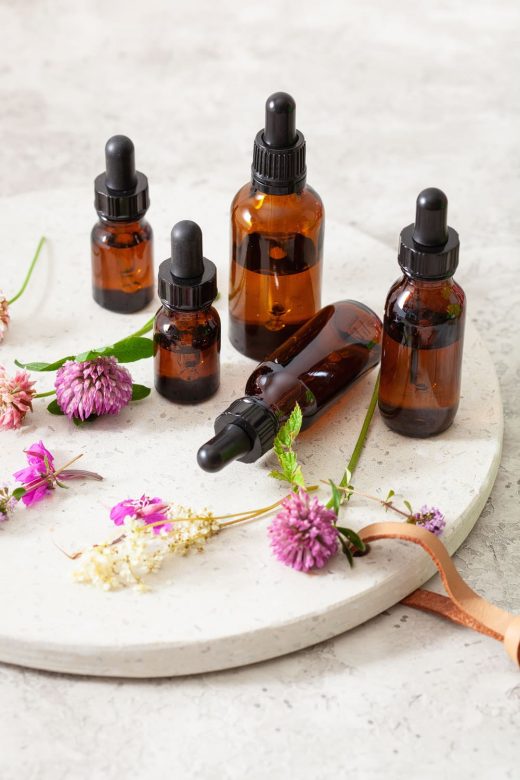
The best antibacterial essential oils for body odor
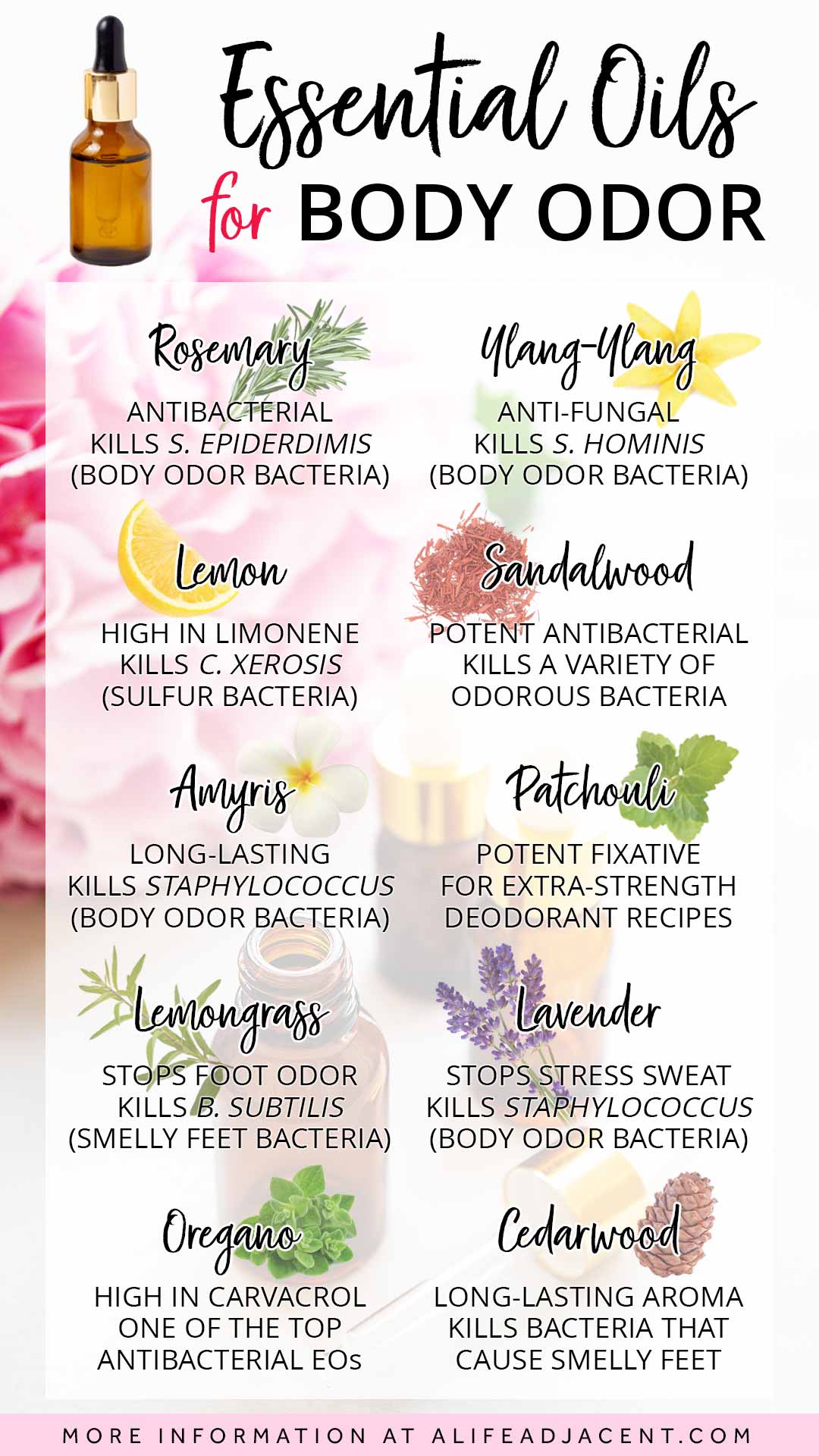
Tea tree essential oil
Tea tree oil is frequently touted as one of the best essential oils for sweating and body odor – and for good reason.
It’s shown potent antibacterial effects against a wide variety of bacteria, including S. hominis, S. epidermidis and S. aureus, three Staphylococcus species responsible for contributing to body odor11.
Tea tree oil has also been shown to inihibit odor-causing Corynebacterium at low concentrations12. Plus, in a study comparing 8 antibacterial essential oils, tea tree oil killed odor-producing bacteria faster than rosemary, peppermint and lavender oil11.
Overall, tea tree oil is an effective addition to any deodorant or deodorizing spray, but only if you enjoy its scent. Tea tree oil has a potent, medicinal aroma that not everyone enjoys.
If you don’t like herbaceous scents, you may prefer to use another essential oil on this list. Luckily, there are many other options that work just as well as tea tree oil.
Blends well with: Neroli, Lemon, Grapefruit, Cedarwood, Cypress
Find it in: Schmidt’s Tea Tree Sensitive Skin Deodorant Stick
Make your own: Herbal Tea Deodorant Recipe
Sandalwood essential oil
Sandalwood essential oil may be expensive, but it’s a powerhouse for preventing body odor, and it contributes significant antibacterial activity to essential oil blends13.
Sandalwood has been shown to inhibit many odor-causing bacteria, including S. hominis and S. epidermidis14. It also strongly inhibits C. xerosis, a bacteria known for its sulforous stink15.
But aside from its impressive antiseptic qualities, sandalwood’s rich, earthy aroma makes it a fantastic oil to include in deodorants or deodorizers. It has a pleasant fragrance that blends well with a variety of other oils.
It’s also incredibly long-lasting. In perfumery, sandalwood is considered a base note. This means it has a tenacious scent that lasts longer than most other essential oils. When used in a deodorant, its fragrance lasts all day.
The only caveat is that pure, high-quality sandalwood oil has a steep price tag. So, you may wish to opt for a sandalwood blend, as this is much more affordable than purchasing the pure oil.
Blends well with: Patchouli, Vanilla, Ylang-Ylang, Sweet Orange
Make your own: BO Be Gone Deodorant Spray
Ylang-ylang essential oil
You don’t typically find ylang-ylang oil on a list antibacterial essential oils, but you should. In fact, it’s one of the best essential oils for preventing a BO emergency.
Ylang-ylang combats body odor two-fold: by killing odor-causing bacteria, and also by masking unpleasant odor with its potent, long-lasting fragrance.
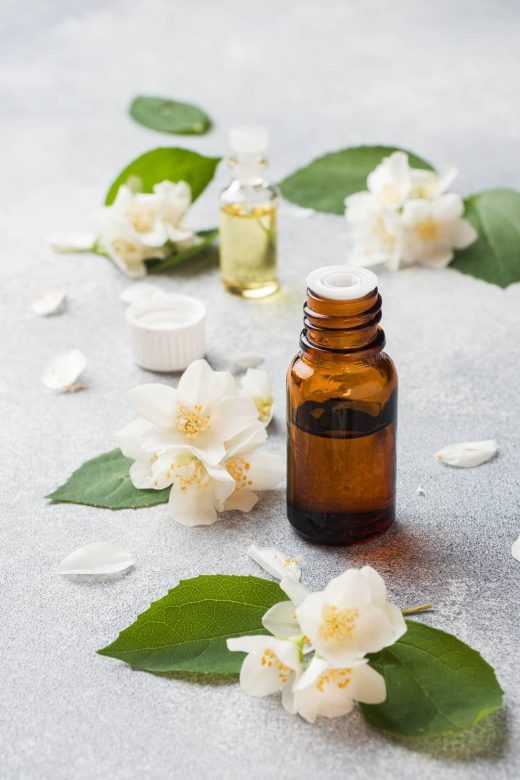
Studies have shown that ylang-ylang oil is particularly effective against S. hominis, one of the main bacterial offenders responsible for smelly armpits16.
Another study found that a mixture of lavender oil, clary sage oil, and ylang ylang oil to be very effective against the bacteria that cause body odor17.
But ylang-ylang isn’t just for armpits – it also inhibits B. subtilis, a bacteria linked to smelly feet18. So, it’s equally useful to include in a foot deodorant.
Overall, ylang-ylang is a wonderful choice to include in any deodorizing essential oil blend. Its calming scent can also promote relaxation and decrease stress-induced sweating.
Blends well with: Grapefruit, Sweet Orange, Lemon, Sandalwood
Find it in: Ylang-ylang Deodorant
Make your own: Cotton Candy Deodorant Spray
Patchouli essential oil
Patchouli essential oil has a divisive fragrance that many either love or hate. No matter where you stand, you may want to consider giving it a chance, as it possesses some unique benefits.

Patchouli oil has been shown to inhibit a wide variety of bacteria that cause body odor, including a couple of the worst offenders: S. hominis and S. epidermidis. In fact, in a study on 14 essential oils and their anti-Staphylococcus activity, patchouli scored in the top 316.
Additionally, in a study of antibacterial essential oil blends, both patchouli and sandalwood contributed the most significant antibacterial activity13.
Therefore, even if you don’t like patchouli’s fragrance on its own, you can still take advantage of its odor-controlling properties by using it in an essential oil blend such as BO Be Gone. A little goes a long way and can help the whole blend last longer.
Patchouli is a base note, and it’s also the most well-known fixative essential oil. Fixatives are very long-lasting. In fact, patchouli’s fragrance can lasts for weeks! You can read more about fixatives in this post on homemade gel air fresheners.
Blends well with: Sandalwood, Grapefruit, Ylang-Ylang, Bergamot, Vanilla
Find it in: Sam’s Natural Patchouli Deodorant
Make your own: BO Be Gone Deodorant Spray
Oregano essential oil
Across the board, oregano frequently scores as one of the most highly antibacterial essential oils. This is not surprising, as it’s very high in carvacrol and thymol, the most active antibacterial terpenes19.
Not only can oregano oil inhibit disease-causing pathogens like E. coli20, but it’s also been shown to kill a variety of body odor-causing bacteria, including B. subtilis, C. xerosis, M. luteus, P. vulgaris21 and a variety of Staphylococcus species11.
Oregano oil has also been studied specifically for its activity against the bacteria responsible for bad perspiration odor, and it performs very well. A group of researchers concluded it would be useful as a natural antimicrobial in personal care products22.
However, as with all potent essential oils, oregano must be used at a very low concentration. A few drops works well in a homemade deodorant or deodorizer, but too much can irritate the skin.
Blends well with: Lemon, Rosemary, Grapefruit, Cedarwood, Basil
Find it in: Dirty Chai Deodorant with Oregano Oil
Thyme essential oil
Thyme is an extremely potent antibacterial essential oil. Thanks to its high concentration of carvacrol and thymol, it can inhibit a wide range of bacteria at very low levels.
In fact, thyme essential oil is even more effective than tea tree oil against odor-causing Staphylococcus bacteria. It also outperforms marjoram, rosemary, basil, peppermint and lavender11.
While thyme can be very useful for body odor, caution must be taken. Its potency also comes with a high potential to irritate the skin.
The maximum dermal concentration for thyme oil is around 1%, so keep this in mind if you’re going to use it in a deodorant.
Blends well with: Lemon, Lavender, Grapefruit, Cedarwood, Sweet Orange
Find it in: Kiss My Face Active Life Sport Deodorant
Lemon essential oil
Lemon essential oil’s fresh, clean scent makes it a classic favourite for cleaning products. But its antiseptic and deodorizing properties also make it useful for eliminating body odor.
The limonene in lemon oil helps makes it effective against various odor-causing bacteria, including C. xerosis3, S. hominis, S. epidermidis, and S. haemolyticus16.
There are many anecdotal accounts of using lemon oil as deodorant. However, it’s important to be cautious. You should never apply lemon oil undiluted to your armpits.
It’s also important to choose the right kind of lemon oil for topical use. Typical cold-pressed lemon essential oil is phototoxic, which means it sensitizes your skin to the sun. However, steam-distilled lemon oil is not.
If you’d like to use the oil on your skin or in a deodorant, you may wish to opt for a steam-distilled oil.
But for other, non-skin uses, such as in deodorizing sprays for stinky shoes or gym clothes, it’s fine to use any kind of lemon oil.
Blends well with: Lavender, Sandalwood, Vanilla, Ylang-Ylang, Cedarwood
Find it in: Desert Essence Lemon Tea Tree Deodorant
Make your own: Herbal Tea Deodorant Spray
Cedarwood essential oil
Fans of cedarwood’s musky aroma will be pleased to know it’s also a potent deodorizer.
Cedarwood oil has powerful antiseptic activity against a wide variety of bacteria. These include, but are not limited to, gram-positive bacteria like S. aureus and S. epidermidis23.
But aside from smelly armpits, cedarwood oil can also be helpful for smelly feet. It inhibits B. subtilis, a bacteria linked to causing bromodosis (foot odor)24. So, it may be useful to incorporate into a homemade foot deodorant.
Cedarwood makes a great addition to any deodorizing blend, especially those where a more masculine scent is preferred.
But that’s not to say cedarwood can’t be used in feminine deodorants, as it pairs well with pink grapefruit or ylang-ylang oils.
Blends well with: Grapefruit, Juniper Berry, Lemon, Fir Needle, Ylang-ylang
Find it in: Schmidt’s Cedarwood + Juniper Deodorant
Make your own: Cedarwood and Juniper Deodorant Spray
Lavender essential oil
It’s no secret that lavender essential oil is extremely popular. Frequently used in deodorant, its potent floral fragrance is very effective at masking bad odors.
But lavender can also reduce body odor at the source, as it inhibits many of the odor-producing bacteria on our skin.

On its own, lavender is especially effective against the Staphyloccocus species11. However, its effects are not quite as strong as some other oils. So for optimum effects, lavender should be incorporated into a blend.
In my experience, a blend of lavender, ylang-ylang, sandalwood, sweet orange and patchouli is very effective for reducing body odor. This particular blend of oils can be found in BO Be Gone.
As well, a study found that blending lavender with clary sage and ylang ylang oil was very effective against body odor-causing bacteria17. So, you could try this blend too.
Aside from its antibacterial properties, lavender’s calming aroma can also help prevent stress-induced sweat.
Blends well with: Lemon, Vanilla, Ylang-Ylang, Neroli, Patchouli, Sandalwood
Find it in: Native Lavender and Rose Deodorant
Make your own: BO Be Gone Deodorant Spray
Amyris essential oil
Amyris essential oil has a pleasant, vanilla-like aroma, so you’d never guess it was so effective for body odor. In fact, amyris oil is so potent that it’s even been studied as a potential treatment for microbial infections25.
In a study on essential oils and S. aureus, amyris scored in the top 326. And in yet another study on essential oils and various Staphylococcus species, amyris inhibited them all at low concentrations16.
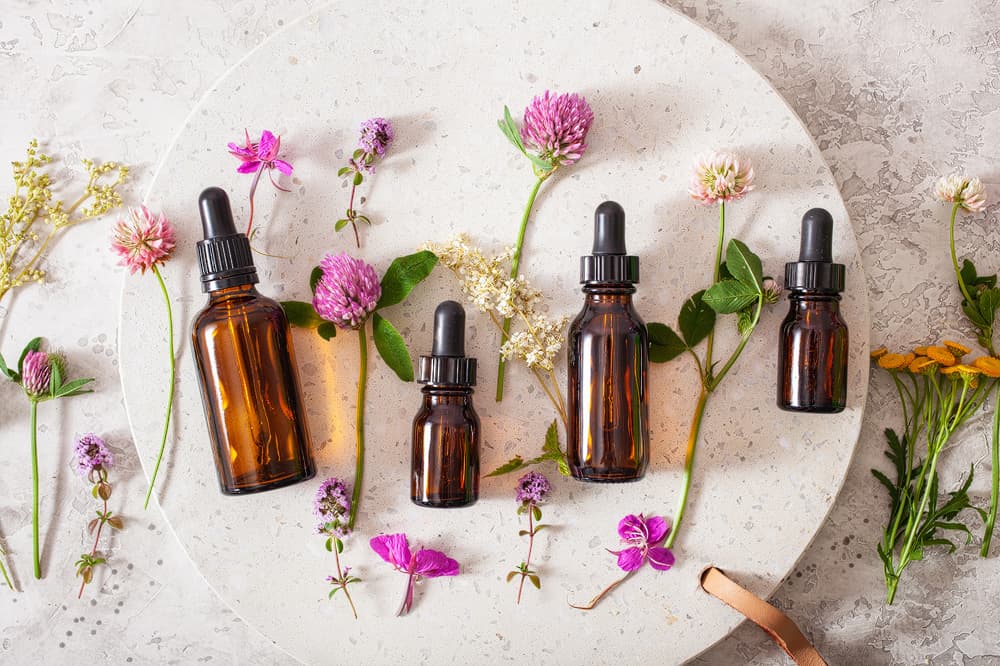
Overall, amyris is a pleasant, mellow oil that complements a variety of other oils. It has good fixative properties as well, so it can help add staying power to any essential oil blend.
Blends well with: Lime, Bergamot, Ylang-Ylang, Petitgrain, Patchouli
Find it in: Routine Deodorant with Amyris, Tobacco, Vetiver & Palo Santo
Grapefruit essential oil
Grapefruit oil has a sweet, uplifting scent that’s similar to sweet orange oil, but more candy-like.
But it doesn’t just smell good – it has a wide variety of antibacterial activity, including against odor-producing S. epidermidis, S. aureus, and P. vulgaris27. It works against B. subtilis too, so you can use it on your feet28.
Grapefruit is one of the most versatile essential oils for deodorant, especially if you enjoy sweet and fruity scents.
Did you know that a combination of grapefruit, ylang-ylang, vanilla, and benzoin smells just like cotton candy? You can also add amyris oil to make the blend last even longer.
When I want to splurge, I always come back to this amazing natural vanilla grapefruit deodorant by LaVanila.
Blends well with: Ylang-Ylang, Vanilla, Benzoin, Lime, Sweet Orange, Cedarwood
Make your own: Cotton Candy Deodorant Spray
Lemongrass essential oil
If you love the crisp, refreshing scent of lemongrass, you’re in luck.
Research has shown that lemongrass essential oil has potent antibacterial properties. It inhibits many of the bacteria that contribute to body odor, including M. luteus28, S. epidermidis, and S. aureus29.
But the most noteworthy result was in this study, where lemongrass was found to be the most effective for killing B. subtilis, the bacteria linked to foot odor28. This makes lemongrass essential oil especially useful for smelly feet.
If you’re making your own foot deodorant or shoe deodorizer, lemongrass is an easy choice. Consider blending it with other foot odor-reducing essential oils such as cedarwood, grapefuit, and ylang-ylang.
Blends well with: Ylang-Ylang, Vanilla, Benzoin, Lime, Sweet Orange, Cedarwood
Find it in: Tom’s of Maine Lemongrass Deodorant
Rosemary essential oil
Rosemary essential oil is an aromatic oil frequently used for respiratory health, but it can also help you smell fresher. It’s shown pronounced activity against microbes, including strains of odor-producing S. epidermidis and S. hominis11.
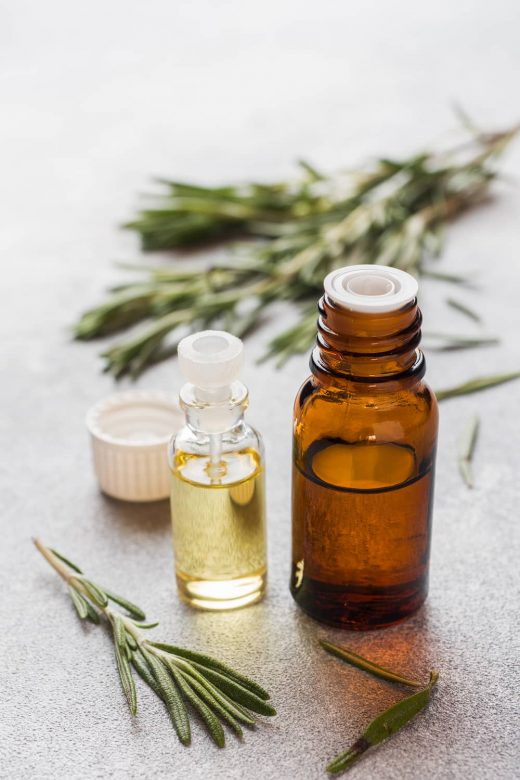
In fact, one study showed that rosemary was more effective than lavender across the board, except for on one strain of S. epidermidis11.
Overall, it’s a great choice for body odor. It has a potent scent, but can be blended with other oils to make it less overpowering.
Blends well with: Lime, Peppermint, Lavender, Sage, Pine, Sweet Orange
Find it in: Earth Science Mint Rosemary Natural Deodorant
Coriander essential oil
Coriander oil comes from the seeds of the cilantro leaf. This lesser-known essential oil isn’t talked about as often as some others, but it looks to be very promising for reducing body odor.
For one, it performs very highly in antimicrobial tests. In one study, coriander oil exhibited bacteriodocidal activity against almond all pathogens tested30.
As an added benefit, coriander oil works at a low inhibitory concentration. This means you don’t need a use a lot for it to be effective. It also appears to have better skin tolerance than potent oils such as oregano and thyme31.
Blends well with: Sage, Lemon, Lavender, Neroli, Cedarwood
Find it in: FATCO Scotch Pine + Coriander Stank Stop Deodorant
Fir essential oil
If you like fresh tree scents, you may want to include fir oils in your deodorizing essential oil blend.
Various oils in the fir family, including balsam fir, fir needle, Korean fir32, and Sicilian fir3, are effective against the bacteria that cause body odor. These include S. epidermidis32, S. aureus33, and C. xerosis3, to name a few.
Arboreal oils blend well with just about any essential oil, whether it’s a citrus like sweet orange or a woody oil like sandalwood. You can also blend various tree oils for a lifelike aroma.
I like to combine fir needle with balsam fir or black spruce for an evergreen-tree like scent. You can also find pre-made tree blends – this one smells just like a Christmas tree.
Blends well with: Spruce, Cypress, Cedarwood, Sandalwood, Sweet Orange
Make your own: Evergreen Tree Deodorant Spray
Cypress essential oil
Cypress oil is frequently used in deodorant for its strong antibacterial and anti-odor properties. It has a fresh and clean fragrance that works well in deodorizing sprays for clothing and other items.
But cypress doesn’t just smell good. There’s evidence that it inhibits odor-causing bacteria such S. aureus32 and S. epidermidis34, as well as other pathogens like E coli. It also kills foot odor-causing B. subtilis35.
Cypress works well in both masculine and feminine scents. You can find it in Timber, a potent essential oil blend that helps control body odor.
Blends well with: Neroli, Lavender, Lemon, Sandalwood, Cedarwood
Find it in: Now Foods Cedarwood + Cypress Deodorant
Pine essential oil
Frequently used as a disinfectant, pine essential oil has shown bacteriocidal activity against various bacteria, including the kind that can cause perspiration odor.
The original Pine-Sol® formula may come to mind. Pine oil is antiseptic against a wide variety of pathogens, so it can be useful for cleaning purposes.
In one study, pine was just as effective as rosemary and eucalyptus for inhibiting S. epidermidis36. It’s also said to help with smelly feet32.
You can blend pine scotch oil with lime and for a pine tree-scented deodorant or odor eliminating spray.
Blends well with: Lime, Cedarwood, Bergamot, Lavender, Juniper Berry
Peppermint essential oil
Peppermint essential oil is very popular and versatile, and it can also be used for odor control.
In one study, peppermint was as effective as tea tree oil against certain bacteria that cause body odor11. However, for it to be effective against S. hominis, it was required in larger amounts.
Overall, it can be a good choice if you like its uplifting fragrance. Since it’s a top note, its fragrance fades quickly. So it should be blended with other oils for improved efficacy and a longer lasting scent.
Blends well with: Lavender, Eucalyptus, Cacao, Rosemary, Cypress
Find it in: Earth Science Mint Rosemary Natural Deodorant
Camphor essential oil
Camphor oil is a strong, medicinal-smelling oil distilled from the wood of the camphor tree.
It has potent antibacterial and odor-reducing activity, and there’s evidence it works against many odor-causing bacteria such as S. hominis, S. epidermidis, and S. haemolyticus16.
In a study of 14 antibacterial essential oils, camphor was found to be the most effective against one type of S. hominis16. Another study showed that a blend of lavender and camphor oil was more potent than either oil on its own37.
Camphor helps boost the overall antibacterial properties of any blend. However, it’s another oil that must be used with caution, as it’s irritating and can be toxic to the skin in high amounts.
Its medicinal scent also isn’t for everyone, so it can be blended with other oils for a more pleasant fragrance.
Blends well with: Lemon, Pine, Cedarwood, Grapefruit, Cypress
Make your own: Fresh Pine Deodorant Spray
Sweet orange essential oil
Don’t let sweet orange essential oil‘s pleasant aroma fool you – this essential oil can still pack a punch against odor.
Not only does it have a strong fragrance, but it’s also reported to inhibit the growth of many different kinds of bacteria and fungi. These include (but are not limited to) S. epidermidis38 and S. aureus32, two Staphyloccocus species linked to producing unpleasant body odor.
In fact, one study found that sweet orange oil was almost as effective as tea tree oil when it came to inhibiting S. aureus39. As well, it tied with ylang-ylang oil for its efficacy against B. subtilis, the smelly feet bacteria.
Sweet orange oil may not be potent enough to eliminate body odor by itself, but it works well in a blend such as BO Be Gone. And when used with medicinal-smelling oils such as tea tree or thyme, it can help improve their fragrance.
Blends well with: Tea Tree, Vanilla, Lavender, Lime, Pine, Cypress, Fir, Sandalwood
Pin it for later
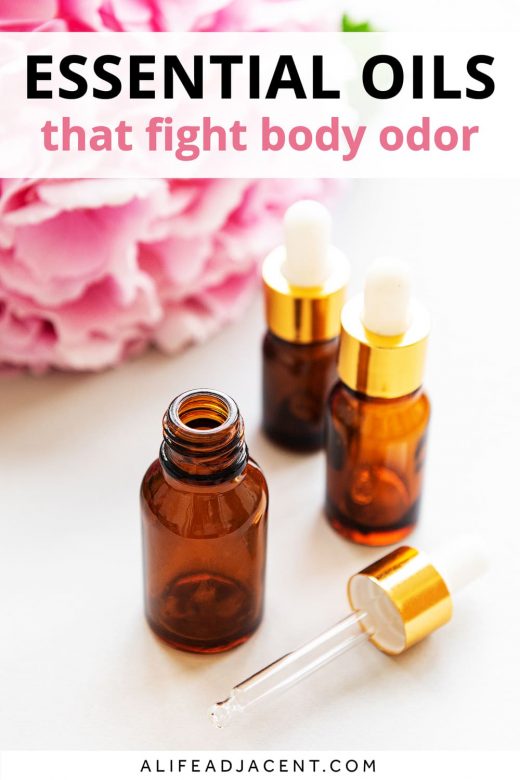
- Rutsch, Poncie. “Meet The Bacteria That Make A Stink In Your Pits.” NPR, NPR, 31 Mar. 2015, www.npr.org/sections/health-shots/2015/03/31/396573607/meet-the-bacteria-that-make-a-stink-in-your-pits.
- Urban, Julie et al. “The effect of habitual and experimental antiperspirant and deodorant product use on the armpit microbiome.” PeerJ vol. 4 e1605. 2 Feb. 2016, doi:10.7717/peerj.1605
- Kanlayavattanakul, M. and Lourith, N. (2011), Body malodours and their topical treatment agents. International Journal of Cosmetic Science, 33: 298-311. https://doi.org/10.1111/j.1468-2494.2011.00649.x
- A. Gordon James, Corrine J. Austin, Diana S. Cox, David Taylor, Ralph Calvert, Microbiological and biochemical origins of human axillary odour, FEMS Microbiology Ecology, Volume 83, Issue 3, March 2013, Pages 527–540, https://doi.org/10.1111/1574-6941.12054
- Urban, Julie et al. “The effect of habitual and experimental antiperspirant and deodorant product use on the armpit microbiome.” PeerJ vol. 4 e1605. 2 Feb. 2016, doi:10.7717/peerj.1605
- Haque, A S M Tanbirul et al. “Composition of Asarum heterotropoides var. mandshuricum radix oil from different extraction methods and activities against human body odor-producing bacteria.” Journal of food and drug analysisvol. 24,4 (2016): 813-821. doi:10.1016/j.jfda.2016.04.006
- Suzuki, Érika Yoko et al. “Potential of the essential oil from Pimenta pseudocaryophyllus as an antimicrobial agent.” Acta pharmaceutica (Zagreb, Croatia) vol. 64,3 (2014): 379-85. doi:10.2478/acph-2014-0024
- Ara, Katsutoshi et al. “Foot odor due to microbial metabolism and its control.” Canadian journal of microbiology vol. 52,4 (2006): 357-64. doi:10.1139/w05-130
- Strauss, John S, and Albert M Kligman. “The Bacteria Responsible for Apocrine Odor.” Journal of Investigative Dermatology, Elsevier, 7 Jan. 2016, www.sciencedirect.com/science/article/pii/S0022202X15488748.
- Lam, T.H., Verzotto, D., Brahma, P. et al. Understanding the microbial basis of body odor in pre-pubescent children and teenagers. Microbiome 6, 213 (2018). https://doi.org/10.1186/s40168-018-0588-z
- Samaras, Yiannis & Chanioti, Marianthi & Koutroullis, G. & Tsiaousi, M. & Eriotou, Effimia. (2010). Antimicrobial Activity of Essential Oils on Staphylococcus sp.
- Carson, C F et al. “Melaleuca alternifolia (Tea Tree) oil: a review of antimicrobial and other medicinal properties.” Clinical microbiology reviews vol. 19,1 (2006): 50-62. doi:10.1128/CMR.19.1.50-62.2006
- Orchard, A et al. “The in vitro antimicrobial evaluation of commercially essential oils and their combinations against acne.” International journal of cosmetic science, 10.1111/ics.12456. 24 Mar. 2018, doi:10.1111/ics.12456
- Moy, Ronald L, and Corey Levenson. “Sandalwood Album Oil as a Botanical Therapeutic in Dermatology.” The Journal of clinical and aesthetic dermatology vol. 10,10 (2017): 34-39.
- Lis-Balchin, Maria. Aromatherapy Science: a Guide for Healthcare Professionals. Pharmaceutical Press, 2006.
- Kačániová, Miroslava et al. “Chemical Composition and Antimicrobial Activity of Selected Essential Oils against Staphylococcus spp.” Antibiotics (Basel, Switzerland) vol. 9,11 765. 31 Oct. 2020, doi:10.3390/antibiotics9110765
- Tadtong, Sarin et al. “Antimicrobial activity of blended essential oil preparation.” Natural product communications vol. 7,10 (2012): 1401-4.
- Akter, Sharmin & Moumita, Anika & Ahmed, Tasnia. (2019). Comparative Study of Antibacterial Activity of Different Essential Oils against Different Bacteria. IJARCCE. 6. 9-18. 10.17148/IARJSET.2019.6602.
- Jafri, Huma & Ansari, Firoz & Ahmad, Iqbal. (2019). Prospects of Essential Oils in Controlling Pathogenic Biofilm. 10.1016/B978-0-12-814619-4.00009-4.
- Sienkiewicz, Monika et al. “Aktywność przeciwbakteryjna olejku oreganowego (Origanum heracleoticum L.) wobec szczepów klinicznych Escherichia coli i Pseudomonas aeruginosa” [The antibacterial activity of oregano essential oil (Origanum heracleoticum L.) against clinical strains of Escherichia coli and Pseudomonas aeruginosa]. Medycyna doswiadczalna i mikrobiologia vol. 64,4 (2012): 297-307.
- Ozkan, Gulcan & Özcan, M.. (2003). Note: Inhibition of Pathogenic Bacteria by Essential Oils at Different Concentrations. Food Science and Technology International – FOOD SCI TECHNOL INT. 9. 85-88. 10.1177/1082013203009002003.
- Suzuki, Érika & Soldati, P.P. & Graças, A.M.C.M. & Raposo, N.R.B.. (2015). Essential Oil from Origanum vulgare Linnaeus: An Alternative Against Microorganisms Responsible for Bad Perspiration Odor. Journal of Young Pharmacists. 7. 12-20. 10.5530/jyp.2015.1.4.
- Wanner, Juergen & Schmidt, Erich & Bail, Stefanie & Jirovetz, Leopold & Buchbauer, Gerhard & Gochev, Velizar & Girova, Tanya & Atanasova, Teodora & Stoyanova, Albena. (2010). Chemical Composition and Antibacterial Activity of Selected Essential Oils and Some of Their Main compounds. Natural product communications. 5. 1359-64. 10.1177/1934578X1000500905.
- Zrira, S. & Ghanmi, Mohamed. (2016). Chemical Composition and Antibacterial Activity of the Essential of Cedrus atlantica (Cedarwood oil). Journal of Essential Oil Bearing Plants. 19. 1267-1272. 10.1080/0972060X.2015.1137499.
- Dahiya, Praveen & Manglik, A.. (2013). Evaluation of antibacterial, antifungal and antioxidant potential of essential oil from Amyris balsamifera against multi drug resistant clinical isolates. Asian Journal of Pharmaceutical and Clinical Research. 6. 57-60.
- Xiao, Shuzhen et al. “Identification of essential oils with activity against stationary phase Staphylococcus aureus.” BMC complementary medicine and therapiesvol. 20,1 99. 24 Mar. 2020, doi:10.1186/s12906-020-02898-4
- Uysal, Burcu & Sozmen, Fazli & Aktas, Ozgur & Oksal, Birsen & Kose, Elif. (2011). Essential oil composition and antibacterial activity of the grapefruit (Citrus Paradisi. L) peel essential oils obtained by solvent-free microwave extraction: Comparison with hydrodistillation. International Journal of Food Science & Technology. 46. 1455 – 1461. 10.1111/j.1365-2621.2011.02640.x.
- Khuntayaporn, Piyatip & Suksiriworapong, Jiraphong. (2017). Efficacy of essential oil formulations against malodor causing bacteria. Pharmaceutical Sciences Asia. 44. 209-216. 10.29090/psa.2017.04.209.
- Subramaniam, Geetha & Yew, Xin & Ambigai, Lalita. (2020). Antibacterial activity of Cymbopogon citratus against clinically important bacteria. South African Journal of Chemical Engineering. 34. 10.1016/j.sajce.2020.05.010.
- Silva, Filomena et al. “Coriander (Coriandrum sativum L.) essential oil: its antibacterial activity and mode of action evaluated by flow cytometry.” Journal of medical microbiologyvol. 60,Pt 10 (2011): 1479-1486. doi:10.1099/jmm.0.034157-0
- Casetti, F et al. “Antimicrobial activity against bacteria with dermatological relevance and skin tolerance of the essential oil from Coriandrum sativum L. fruits.” Phytotherapy research : PTR vol. 26,3 (2012): 420-4. doi:10.1002/ptr.3571
- Orchard, Ané, and Sandy van Vuuren. “Commercial Essential Oils as Potential Antimicrobials to Treat Skin Diseases.” Evidence-based complementary and alternative medicine : eCAM vol. 2017 (2017): 4517971. doi:10.1155/2017/4517971
- Pichette, André et al. “Composition and antibacterial activity of Abies balsamea essential oil.” Phytotherapy research : PTR vol. 20,5 (2006): 371-3. doi:10.1002/ptr.1863
- Al-Mouhajer, Layla & Chabo, Roula & Saab, Antoine & Saade, Katia & Makhlouf, Hassane. (2017). ANTIBACTERIAL ACTIVITIES OF ESSENTIAL OILS ISOLATED FROM TWO SPECIES CUPRESSUS ARIZONICA GREENE AND CUPRESSUS SEMPERVIRENS L. (VAR. HORIZONTALIS AND PYRAMIDALIS).
- Orhan, Ilkay Erdogan, and Ibrahim Tumen. “Potential of Cupressus sempervirens (Mediterranean Cypress) in Health.” The Mediterranean Diet(2015): 639–647. doi:10.1016/B978-0-12-407849-9.00057-9
- Tadtong, Sarin et al. “Antimicrobial Constituents and Effects of Blended Eucalyptus, Rosemary, Patchouli, Pine, and Cajuput Essential Oils.” Natural product communications vol. 11,2 (2016): 267-70.
- Karaca, Nursenem, Görkem Şener, Betül Demirci, and Fatih Demirci. ” Synergistic antibacterial combination of Lavandula latifolia Medik. essential oil with camphor”. Zeitschrift für Naturforschung C (published online ahead of print 2020), 000010151520200051. https://doi.org/10.1515/znc-2020-0051 Web.
- Javed, Shabnam & Mahmood, Zaid & Shoaib, Amna & Javaid, Dr. Arshad. (2011). Biocidal activity of citrus peel essential oils against some food spoilage bacteria. Journal of Medicinal Plants Research. 5. 2868-2872.
- Akter, Sharmin & Moumita, Anika & Ahmed, Tasnia. (2019). Comparative Study of Antibacterial Activity of Different Essential Oils against Different Bacteria. IJARCCE. 6. 9-18. 10.17148/IARJSET.2019.6602.


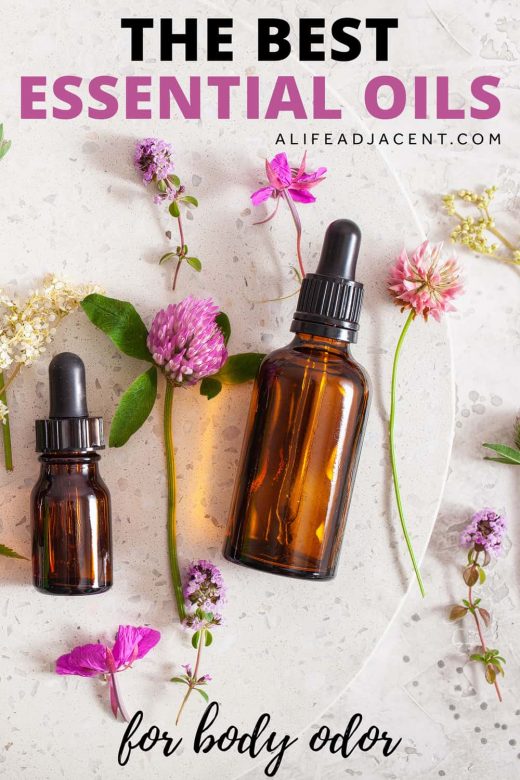
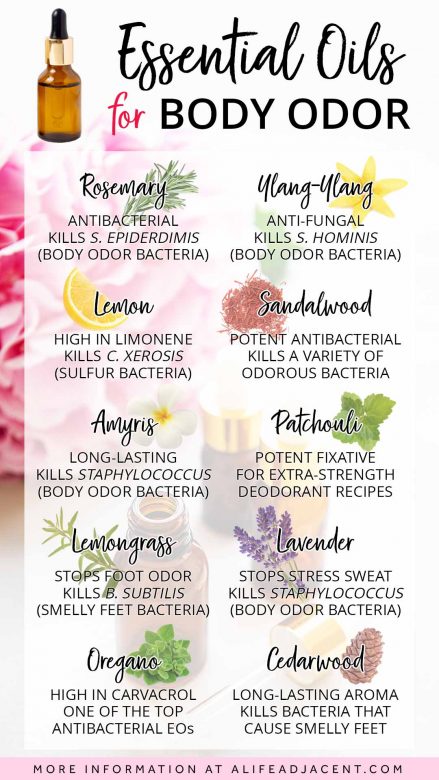
Carol Karl
Friday 23rd of April 2021
Do you have any suggestions for getting sweat smells out of gym clothes? I add bergamot oil to my laundry which helps but I still get some smell staying on the clothes. Thanks.
Kyla
Sunday 25th of April 2021
Hi Carol, you could also try the "BO Be Gone" essential oil blend mentioned in this post on DIY deodorant spray. Someone reported it was very effective for sweat smells in clothes. Hope this helps!
Kim
Saturday 24th of April 2021
Hi Carol, you could try pre-soaking in vinegar or google "laundry stripping" as that can help remove odors as well. Hope that helps!